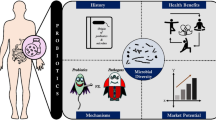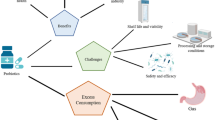Abstract
The central goal of this study was to analyze scientific trends in the research on probiotics, including the number of papers, funding, country collaborations, and most cited publications. The study makes use of bibliometric and social network analysis of papers included in the Science Citation Index Expanded from the Web of Science database. A total of 7221 papers were retrieved, from which 64% were funded papers. Papers were published in journals covering several areas, such as Food Science & Technology, Microbiology, Biotechnology and Applied Microbiology, Nutrition & Dietetics and Agriculture, and Dairy & Animal Science. Coword analysis shows the relationships between microorganisms, diseases, physiological phenomena, and other key words related to food, population, or type of study. The USA appeared as the world leader in the number of articles produced (n = 919), followed by China (n = 689), India (n = 633), and Brazil (n = 506). The most cited papers related to the consensus on the scope and appropriate use of the term probiotic, its effects on the prevention and treatment of some intestinal diseases, its effects on the suppression of immune disorders, the role of probiotics and prebiotics in obesity, the assessment of psychotropic-like properties, and the application for type 2 diabetes.





Similar content being viewed by others
Data Availability
All data are from the Web of Science, an online subscription-based scientific citation indexing service originally produced by the Institute for Scientific Information (ISI), now maintained by Clarivate Analytics. The data generated and used during this research are openly available from Zenodo.org public repository at https://doi.org/10.5281/zenodo.2553182.
References
Smyrna G (2011) Probiotics-friendly bacterias with a host benefits. J Nurs 2(1):42–43
Tormo Carnice R (2006) Probióticos. Concepto y mecanismo de acción. An Pediatr Monogr 4(1):30–41
Thomas DV, Greer FR, American Academy of Pediatrics Committee on N, American Academy of Pediatrics Section on Gastroenterology H, Nutrition (2010) Probiotics and prebiotics in pediatrics. Pediatrics 26(6):1217–1231. https://doi.org/10.1542/peds.2010-2548
Morelli L, Capurso L (2012) FAO/WHO guidelines on probiotics: 10 years later. J Clin Gastroenterol 46(Suppl):S1–S2. https://doi.org/10.1097/MCG.0b013e318269fdd5
Amagase H (2008) Current marketplace for probiotics: a Japanese perspective. Clin Infect Dis 46(Suppl 2):S73–S75. Discussion S144-51. https://doi.org/10.1086/523338
Raja BR, Arunachalam KD (2011) Market potential for probiotic nutritional supplements in India. Afr J Bus Manag 5(14):5418–5423. https://doi.org/10.5897/AJBM11.494
Mulder IE, Schmid B, Stokes CR, Lewis M, Bailey M, Aminov RI et al (2009) Environmentally acquired bacteria influence microbial diversity and naturalinnate immune response a gut surfaces. BMC Biol 7:79. https://doi.org/10.1186/1741-7007-7-79
Nikniaz Z, Nikniaz L, Bilan N, Somi MH, Faramarzi E (2017) Does probiotic supplementation affect pulmonary exacerbation and intestinal inflammation in cystic fibrosis: a systematic review of randomized clinical trials. World J Pediatr 13(4):307–313. https://doi.org/10.1007/s12519-017-0033-6
Nadelman P, Magno MB, Masterson D, da Cruz AG, Maia LC (2018) Are dairy products containing probiotics beneficial for oral health? A systematic review and meta-analysis. Clin Oral Investig 22(8):2763–2785. https://doi.org/10.1007/s00784-018-2682-9
Lloyd-Lavery A, Rogers NK, Davies E, Grindlay DJC, Thomas KS (2018) What's new in atopic eczema? An analysis of systematic reviews published in 2015. Part 2: prevention and treatment. Clin Exp Dermatol 43(6):653–658. https://doi.org/10.1111/ced.13377
Sniffen JC, McFarland LV, Evans CT, Goldstein EJC (2018) Choosing an appropriate probiotic product for your patient: an evidence-based practical guide. PLoS One 13(12):e0209205. https://doi.org/10.1371/journal.pone.0209205
Williams G, Hodson EM, Craig JC (2019) Interventions for primary vesicoureteric reflux. Cochrane Database Syst Rev 2:CD001532. https://doi.org/10.1002/14651858.CD001532.pub5
Pammi M, Abrams SA (2019) Enteral lactoferrin for the treatment of sepsis and necrotizing enterocolitis in neonates. Cochrane Database Syst Rev 5:CD007138. https://doi.org/10.1002/14651858.CD007138.pub4
Guo Q, Goldenberg JZ, Humphrey C, El Dib R, Johnston BC (2019) Probiotics for the prevention of pediatric antibiotic-associated diarrhea. Cochrane Database Syst Rev 4:CD004827. https://doi.org/10.1002/14651858.CD004827.pub5
Shi X, Zhang J, Mo L, Shi J, Qin M, Huang X (2019) Efficacy and safety of probiotics in eradicating Helicobacter pylori: a network meta-analysis. Medicine (Baltimore) 98(15):e15180. https://doi.org/10.1097/MD.0000000000015180
Saa C, Bunout D, Hirsch S (2019) Industry funding effect on positive results of probiotic use in the management of acute diarrhea: a systematized review. Eur J Gastroenterol Hepatol 31(3):289–302. https://doi.org/10.1097/MEG.0000000000001322
Batagelj V, Mrvar AP (2002) Analysis and visualization of large networks. Lect Notes Comput Sci 2265:477–478. https://doi.org/10.1186/s40294-016-0017-8
Ho YS (2007) Bibliometric analysis of adsorption technology in environmental science. J Environ Prot 1(1):1–11
Chiu WT, Ho YS (2007) Bibliometric analysis of tsunami research. Scientometrics 73:3–17. https://doi.org/10.1007/s11192-005-1523-1
Aleixandre-Benavent R, Aleixandre-Tudó JL, Castelló-Cogollos L, Aleixandre JL (2017) Trends in scientific research on climate change in agriculture and forestry subject areas (2005-2014). J Clean Prod 147:406–418. https://doi.org/10.1016/j.jclepro.2017.01.112
Sweileh WM, Shraim NY, Al-Jabi SW, Sawalha AF, Rahhal B, Khayyat RA, Sa’ed HZ (2016) Assessing worldwide research activity on probiotics in pediatrics using Scopus database: 1994-2014. World Allergy Org J 9:25. https://doi.org/10.1186/s40413-016-0116-1
Degnan FH (2008) The US Food and Drug Administration and probiotics: regulatory categorization. Clin Infect Dis 46(Suppl 2):S133–S136. https://doi.org/10.1086/523324
Katan MB (2012) Why the European food safety authority was right to reject health claims for probiotics. Benefic Microbes 3(2):85–89. https://doi.org/10.3920/BM2012.0008
Rowland I, Capurso L, Collins K, Cummings J, Delzenne N, Goulet O et al (2010) Current level of consensus on probiotic science: report of an expert meeting-London, 23 November 2009. Gut Microbes 1(6):436–439. https://doi.org/10.4161/gmic.1.6.13610
Venugopalan V, Shriner KA, Wong-Beringer A (2010) Regulatory oversight and safety of probiotic use. Emerg Infect Dis 16(11):1661–1665
von Wright A (2005) Regulating the safety of probiotics--the European approach. Curr Pharm Des 11(1):17–23. https://doi.org/10.2174/1381612053382322
Hoffmann DE, Fraser CM, Palumbo FB, Ravel J, Rothenberg K, Rowthorn V, Schwartz J (2013) Science and regulation. Probiotics: finding the right regulatory balance. Science (New York, NY) 342(6156):314–315. https://doi.org/10.1126/science.1244656
Marcason W (2013) Probiotics: where do we stand? J Acad Nutr Diet 113(10):1424. https://doi.org/10.1016/j.jand.2013.08.010
Euromonitor. Trends, innovations and opportunities driving the global probiotics market. Accessed 22/1/2019. Available at: https://go.euromonitor.com/EV-NA2017-Probiota-Americas_Landing-Page.html?utm_campaign=EV-NA2017-Probiota%2520Americas&utm_medium=Blog&utm_source=Blog
Kristensen NB, Bryrup T, Allin KH, Nielsen T, Hansen TH, Pedersen O (2016) Alterations in fecal microbiota composition by probiotic supplementation in healthy adults: a systematic review of randomized controlled trials. Genome Med 8(1):52. https://doi.org/10.1186/s13073-016-0300-5
Stanton C, Gardiner G, Meehan H, Collins K, Fitzgerald G, Lynch PB, Ross RP (2001) Market potential for probiotics. Am J Clin Nutr 73(2 Suppl):476S–483S. https://doi.org/10.1093/ajcn/73.2.4765
Goldenberg JZ, Yap C, Lytvyn L, Lo CK, Beardsley J, Mertz D, Johnston BC (2017) Probiotics for the prevention of Clostridium difficile-associated diarrhea in adults and children. Cochrane Database Syst Rev 12:CD006095. https://doi.org/10.1002/14651858.CD006095.pub4
Guarner F, Khan AG, Garisch J, Eliakim R, Gangl A, Thomson A et al (2012) World gastroenterology organisation global guidelines. Probiotics and prebiotics. J Clin Gastroenterol 46(6):468–481
Hempel S, Newberry S, Maher AR, Wang Z, Miles JN, Shanman R, Johnsen B, Shekelle PG (2012) Probiotics for the prevention and treatment of antibiotic-associated diarrhea: a systematic review and meta-analysis. JAMA 307(18):1959–1969. https://doi.org/10.1001/jama.2012.3507
Hibberd PL, Kleimola L, Fiorino AM, Botelho C, Haverkamp M, Andreyeva I et al (2014) No evidence of harms of probiotic Lactobacillus rhamnosus GG ATCC 53103 in healthy elderly—a phase I open label study to assess safety, tolerability and cytokine responses. PLoS One 9(12):e113456. https://doi.org/10.1371/journal.pone.0113456
Moayyedi P, Ford AC, Talley NJ, Cremonini F, Foxx-Orenstein AE, Brandt LJ, Quigley EM (2010) The efficacy of probiotics in the treatment of irritable bowel syndrome: a systematic review. Gut 59(3):325–332. https://doi.org/10.1136/gut.2008.167270
Allen SJ, Martinez EG, Gregorio GV, Dans LF (2010) Probiotics for treating acute infectious diarrhoea. Cochrane Database Syst Rev (11):CD003048. Accessed at www.thecochranelibrary.com on April 24, 2015. https://doi.org/10.1002/14651858.CD003048.pub3
Bizzini B, Pizzo G, Scapagnini G, Nuzzo D, Vasto S (2012) Probiotics and oral health. Curr Pharm Des 18(34):5522–5531
Black LI, Clarke TC, Barnes PM, Stussman BJ, Nahin RL (2015) Use of complementary health approaches among children aged 4-17 years in the United States: National health interview survey, 2007-2012. National health statistics reports; no 78. National Center for Health Statistics, Hyattsville
Clarke TC, Black LI, Stussman BJ, Barnes PM, Nahin RL (2015) Trends in the use of complementary health approaches among adults: United States, 2002–2012. National health statistics reports; no 79. National Center for Health Statistics, Hyattsville
Marketsandmarkets.com. Probiotic ingredients market by function (regular, preventative, therapy), application (food & beverage, dietary supplements & animal probiotics), ingredient (bacteria & yeast), and by region - global trends & forecast to 2020. Available at: http://www.marketsandmarkets.com/Market-Reports/probiotic-market-advanced-technologies-and-global-market-69.html. Accessed 8 Jan 2019
National Center for Complementary and Integrative Health. US National Institutes of Health. Probiotics: in depth. Consulted 16/10/2018. Available from https://nccih.nih.gov/health/probiotics/introduction.htm
Funding
LCC and RAB are funded by Spanish Ministry of Economy and Competitiveness (CSO2015-65594-C2-2-R0).
Author information
Authors and Affiliations
Corresponding author
Ethics declarations
Conflict of Interest
The authors declare that they have no conflict of interest.
The authors do not have a financial relationship with the organization that sponsored the research.
Additional information
Publisher’s Note
Springer Nature remains neutral with regard to jurisdictional claims in published maps and institutional affiliations.
Rights and permissions
About this article
Cite this article
Aleixandre-Tudó, J.L., Castelló-Cogollos, L., Aleixandre, J.L. et al. Tendencies and Challenges in Worldwide Scientific Research on Probiotics. Probiotics & Antimicro. Prot. 12, 785–797 (2020). https://doi.org/10.1007/s12602-019-09591-0
Published:
Issue Date:
DOI: https://doi.org/10.1007/s12602-019-09591-0




